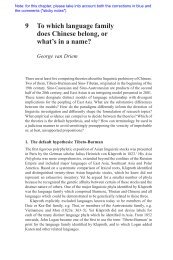1 Austronesian cultural origins
1 Austronesian cultural origins
1 Austronesian cultural origins
You also want an ePaper? Increase the reach of your titles
YUMPU automatically turns print PDFs into web optimized ePapers that Google loves.
26 Peter Bellwood and Eusebio Dizon<br />
region for the movement to the Marianas, the existing Neolithic sequence in the<br />
open sites in the Cagayan Valley goes back to about 2000 bc (Hung 2005).<br />
Of course, in talking about archaeological dates for earliest human settlement,<br />
there exists the question of how long, in statistical average terms, it will take<br />
archaeologists to find the oldest sites in any given area. Common sense dictates<br />
that early immigrant populations would have been small. Pioneer archaeologists<br />
will not find the oldest sites immediately unless they are extremely lucky, and<br />
will often be led astray by spuriously old C 14 dates from peripheral locations<br />
that have been blessed with strong research profiles. An example of this comes<br />
from the record of Lapita discovery in western Oceania, with the early claim<br />
by biological anthropologist William Howells (1973) that ancestral Polynesians<br />
migrated through Micronesia into Fiji and Western Polynesia, avoiding most of<br />
Melanesia at first, partly because the C 14 dates were oldest in Fiji at that time<br />
(Howells also, of course, relied on biological evidence to support his views). But<br />
now, after several decades of very intensive Lapita research, it has become clear<br />
that Lapita began in the far west of Melanesia (Bismarck Archipelago) at about<br />
1,400 bc, and only in actuality reached Fiji about 1000 bc or later (Green 2003).<br />
Radiocarbon dates can sometimes be misleading in <strong>cultural</strong> terms.<br />
What of regions like the northern Philippines, where the relevant research is<br />
much newer? Have we found the very oldest sites here? Surely, we need to allow a<br />
couple of centuries in most South‑east Asian regions to allow populations to grow<br />
to archaeologically visible sizes, particularly on very large islands such as Luzon,<br />
Sulawesi and Borneo. This, combined with the younger dating that has occurred<br />
with the increasing density of research on much smaller islands in western<br />
Polynesia and Fiji, of course expands the dispersal chronology considerably,<br />
moving the dates backwards (older) towards 2,500 bc for the northern Philippines,<br />
but forwards (younger) towards 1000 bc for Fiji and Tonga (Spriggs 2003; Green<br />
2003). This suggests a total time span close to 1,500 years for Neolithic spread<br />
from Taiwan to western Polynesia, perhaps not quite an express train, although<br />
our suspicion from available C 14 dates is that movement could have been very<br />
rapid indeed in some parts of the range. This step‑like progression is discussed<br />
further below.<br />
The Batanes Islands<br />
The Batanes Islands lie 150 km from the southern tip of Taiwan and 200 km from<br />
the north coast of Luzon (Map 1.II). The open sea distance from Lanyu (off south‑<br />
eastern Taiwan) to Mavolis (northern Batanes) is about 100 km, and once this<br />
point was reached all other islands of the Batanes would have been intervisible.<br />
Since 2002, the two authors have been conducting archaeological research in<br />
these islands, with colleagues from the Australian National University, National<br />
Museum of the Philippines and the University of the Philippines (Bellwood et al.<br />
2003; Bellwood and Dizon 2005). 1 This research has focused mainly on Batan<br />
and Itbayat Islands and takes us back to about 2000 bc.



